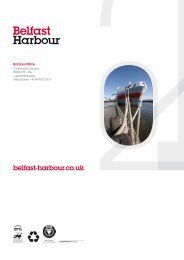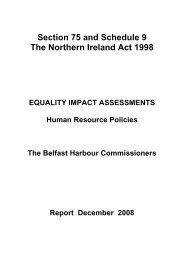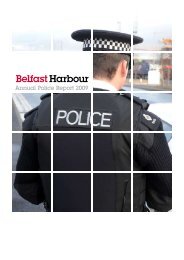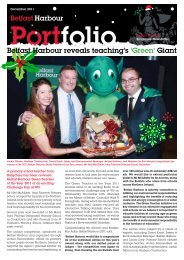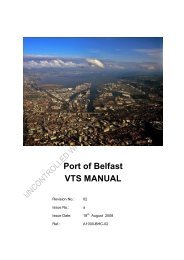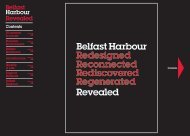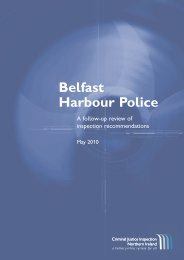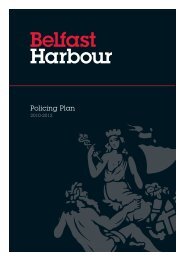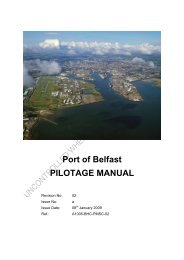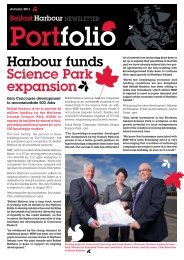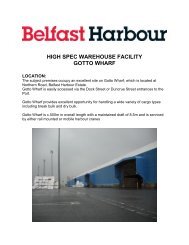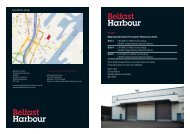Corporate Plan 2008 - 2012 - Belfast Harbour
Corporate Plan 2008 - 2012 - Belfast Harbour
Corporate Plan 2008 - 2012 - Belfast Harbour
Create successful ePaper yourself
Turn your PDF publications into a flip-book with our unique Google optimized e-Paper software.
Business Powers<br />
It was decided by the previous Assembly that<br />
Trust Ports had insufficient commercial freedom and<br />
that consequently the ports were not positioned to<br />
maximise their financial performance for the benefit<br />
of the economy.<br />
This remains very much the case and, given the<br />
aforementioned need to double port capacity by<br />
2025, it is vital that the ports are enabled to achieve<br />
greater returns.<br />
There remains the risk that, without this approach,<br />
the level of spending required will ultimately result in<br />
the NI Trust Ports being unable to self-finance the very<br />
significant infrastructure investments needed to deliver<br />
the additional capacity required.<br />
The Port’s role as an economic driver is easily<br />
recognised on the marine side of the business where<br />
enabling and promoting trade have very significant<br />
positive consequences for the region.<br />
During the life of this <strong>Corporate</strong> <strong>Plan</strong>, the Port’s ability<br />
to enhance its role as an economic catalyst through the<br />
development of Titanic Quarter lands and other aspects<br />
of the Property portfolio will come to the fore. Indeed,<br />
this is already evident through the Port’s participation<br />
in the provision of office facilities in advance of their<br />
letting to Foreign Direct Investors and such commitment<br />
during the <strong>Plan</strong> will enable the creation of further high<br />
value jobs and the introduction of key businesses to the<br />
benefit of the local economy.<br />
Land Ownership<br />
Whilst the Northern Ireland Port Policy Review<br />
has afforded the opportunity to examine the above<br />
issues, it also raised the question of the Port of <strong>Belfast</strong>’s<br />
land bank.<br />
The Port of <strong>Belfast</strong> has a successful track record of<br />
land stewardship and has widely communicated the<br />
importance of Estate revenues to the funding of Port<br />
capacity. Notwithstanding this, there exists a view in<br />
some quarters that the Port of <strong>Belfast</strong> land bank might<br />
be expropriated and put to other use.<br />
Such an action would render the organisation<br />
incapable of self-funding the necessary port capacity<br />
to support the projected long term growth of the<br />
regional economy.<br />
Stakeholder Context<br />
As a Trust Port, the Port of <strong>Belfast</strong>’s relationship with<br />
its Stakeholders is a vital element of the business.<br />
Stakeholders include direct and indirect port customers,<br />
port service providers, employees, manufacturers,<br />
tenants, developers, government, communities and<br />
other general public interest organisations.<br />
Catalyst for Economic Development<br />
Working in the Public Interest is central to the value<br />
system of the business and is demonstrated in the<br />
facilitation of key projects such as the Titanic Signature<br />
Project, Northern Ireland Science Park and Odyssey.<br />
School children from four <strong>Belfast</strong> schools visit The <strong>Harbour</strong> Office.<br />
Customers<br />
The most significant Port customer issue during the<br />
life of the <strong>Plan</strong> is the provision of marine capacity,<br />
particularly that related to containers.<br />
As customers seek economies of scale, average vessel<br />
sizes continue to increase in length and draft. These<br />
increases in ship sizes are paralleled by customer<br />
requirements for higher cargo discharge rates and<br />
faster vessel turnaround times.<br />
Such customer needs require the Port to provide:<br />
increased out-of-hours support; longer and deeper<br />
berths; higher capacity cranes; and reinforced quays<br />
and hinterland to accommodate ever larger secondaryhandling<br />
equipment.<br />
Ship manoeuvrability is also increasing as customers<br />
invest in more sophisticated vessels to improve safety<br />
and reduce the cost of towage. Competent <strong>Harbour</strong><br />
Authorities must respond to these changes by ensuring<br />
that proscribed Towage Requirements are safe and can<br />
be efficiently delivered.<br />
Page 16



